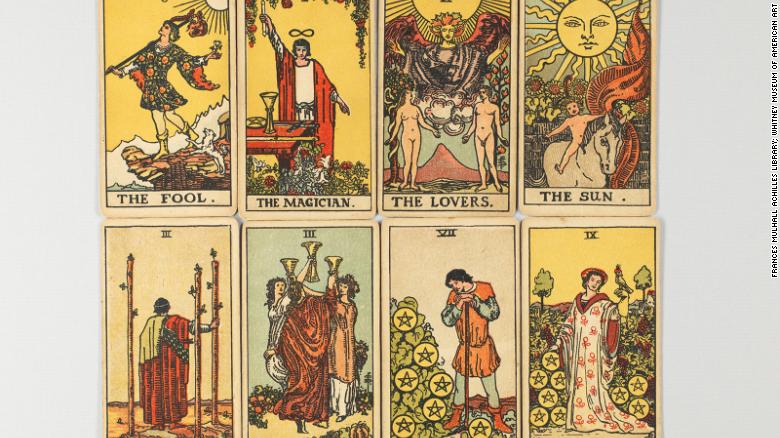
There are a few basic tarot spreads that you can try. There's the Situation-action-outcome tarot spread, the Past-present-future tarot spread, and the Celtic cross tarot spread. If you're a beginner, the basic spreads can be easy to understand and are a great place to start.
Simple tarot spreads
Tarot Spreads require no prior experience. They are simple but can give you a lot of useful information. These spreads are especially useful for general overviews and interrelated topics. Their free-form nature also allows for flexibility in interpretation. Here are some simple Tarot Spreads.
The situation you are trying to understand is represented by the first card. The second card is the challenge or blockage that needs to be overcome. The third card centers on the past. The fourth card is about the future. The fifth card shows the unconscious and conscious thoughts of an individual. The final card is the opposite of the last one, showing the perceptions of the other person.

Situation-action-outcome tarot spread
The Situation. Action. Outcome tarot deck is a 3-card spread that examines possible outcomes to a situation. Although it's not a love reading, this reading is popular for questions about relationships and love. Although it may not give you the full picture of a situation, it does reveal aspects that you may not have noticed otherwise.
This type of tarot spread is great for gaining more information. It is commonly used for love tarot and has three cards in the top row, and two cards in the bottom. The spread is drawn by drawing the first card from each row. This represents you. The second represents your partner.
Past-present-future tarot spread
The Past-present, future Tarot spread can help you connect to your past as well as your future. You can use this spread in many different ways, depending upon your preferences. The spread is composed of three cards placed side by side. The cards are placed so that the Four Elements run across each card, covering money, relationships, and work.
The Past-Present Future Tarot Spread is one of the most loved three-card spreads. It is especially useful when you want to ask about timing. The first card is a representation of elements that influence the present. The current situation is represented by the second card, while the probable outcome of the third card is shown. You can use the Past-Present Future Tarot spread to your advantage by meditating on the first card in line-up and visualizing it as the answer to the question.

Celtic cross tarot spread
The Celtic cross Tarot Spread is one of the oldest layouts. It can be used to find out how your life is going, or for more specific questions. There are a few different variations of this layout, with each position having slightly different meanings.
The Celtic cross is divided into two sections: the first section includes the querent and the second section is for the block. The root of the problem or the unconscious energy that is causing the issue, is the third section.
FAQ
What is a hobby for kids?
A hobby for kids is any activity they like to do as part of their normal daily routine. They might like to draw pictures, build things, paint, write stories, play with toys, read books, watch TV, listen to music, play computer games, ride bikes, skateboard, swim, climb trees, run around outside, play football, basketball, volleyball, rugby, cricket, baseball, soccer, hockey, dodgeball, rounders, tag, hide and seek, hopscotch, marbles, jump rope, hopscotch and many others.
Many parents worry that their kids will get into trouble when they're free to do what they want. But this isn't always true. Your child will not get into trouble if he or she is safe and doesn’t cause any harm to other people or themselves.
It's important for people to understand that just because they like something doesn't necessarily mean they'll choose it all the time. If they dislike writing but enjoy drawing pictures, they might opt to draw pictures.
There are many hobbies available, so you can choose the one you like best.
What are your top hobbies?
You can find the best hobbies that you love doing for yourself. If you enjoy what you do, it will be much easier to keep going. If you don't feel well or tired, you will always have an excuse!
We all have hobbies that we love and know. These include painting, crafting, photography, cooking and sports.
Volunteering could be a great option.
Perhaps you want something more adventurous. Why not take up scuba diving, rock climbing, sky diving, bungee jumping, white water rafting, sailing, surfing, canoeing, kayaking, horse riding, zip lining, hang gliding, paragliding, skydiving, snowboarding, skiing, mountain biking, hiking, camping, fishing, hunting, archery, shooting, clay pigeon shooting, target shooting, golf, tennis, swimming, snorkeling, windsurfing, waterskiing, kitesurfing, wakeboarding, standup paddle boarding, hang gliding, parasailing, hot air ballooning, paragliding and many more.
If you want to go further afield, there are plenty of unique ways to spend time in nature. These include caving, cliff diving, cave tubing, abseiling, sea kayaking, rafting, canoeing, climbing, trekking, bushwalking, mountaineering, backpacking, trail running, orienteering, off-road driving, quad biking, motorcycling, motorcycle riding, dirt bike riding, jet boating, hang gliding, hang gliding, parachuting, hang gliding, heli-skiing, ice skating, snowmobiling, snowshoeing, snowshoeing, cross country skiing, downhill skiing, telemark skiing, ski touring, sled dog racing, snowboarding, snowkiting, snowmobiling, spelunking, snowshoe hiking, snowshoeing and many more.
What are your competitive hobbies?
You can compete in running, swimming or cycling as well golfing or tennis.
They're usually played by people who enjoy physical activity but also provide an opportunity for social interaction.
You'll likely find others who are interested in your hobby if it involves physical activity.
This may mean joining a club or group where you meet regularly to play sports together.
You can also participate in team games where you play alongside others.
These include cricket, football, netball, hockey, netball, soccer, rugby, cricket, rugby, batsball, hockey, volleyball, badminton squash, handball and table tennis.
There are many different types of competition.
Some competitions exist solely for recreational purposes.
Others are meant to test competitors' skills.
Some are even designed to reward outstanding performance.
These cases award prizes to the winners.
Other competitions aim to assess the strength and endurance of competitors.
These are called endurance events.
For example, marathon races, triathlons, Ironman Triathlon, etc.
Athletes train hard before they compete in these events.
To prepare them mentally and physically, they will be following a strict training regimen.
They might also have to travel for preparation.
It's important not to forget that not all athletes are able to compete in every type event.
What are some good hobbies?
Hobby Ideas For People Who Love to Teach and Learn.
Hobbies are a great way for you to do what you love and also learn something new.
Although there are many hobbies to choose from, they all share some common characteristics. They are usually enjoyable activities that don't require a lot of effort and can be very economical.
They also tend to involve working with others, whether teaching someone how to play an instrument or helping them build a model airplane.
You might not think about yourself as a teacher, but chances are there's something you could do to help someone else learn.
So if you want to be more creative in your life, consider starting a hobby where you can use your skills to help others.
What does a hobby cost?
The only thing that costs less than a hobby is time. If you're serious about it, however, it may take you many years to reach your goals.
However, there is something that can help. It's called passion'. Passion will help you put in the effort to succeed.
Once you put in the hours, you might find yourself addicted to the activity. Here is the fun part! Because you are enjoying what you are doing and are constantly improving. You'll probably see a substantial improvement by the end.
It doesn't matter how long it takes. Don't be afraid to try. You might be surprised by what you find!
Statistics
- Studies show that just six minutes of reading can reduce stress levels by 60 percent. (oberlo.com)
- The intensity of the dialogue partners' bond at the end of the forty-five-minute vulnerability interaction was rated as closer than the closest relationship in the lives of 30 percent of similar students. (time.com)
- A new survey by Pew Research Center of teens ages 13 to 17 finds that 36% of girls feel tense or nervous about their day every day; 23% of boys say the same. (pewresearch.org)
- Almost 80% of people claim to have no hobby. (hobbylark.com)
- This 100% accurate personality-analyzing hobby quiz discovers your passion based on your characteristics. (quizexpo.com)
External Links
How To
How to Start Gardening
Gardening is one form of agriculture that dates back to the beginning. It requires patience, persistence and determination. You must choose a suitable location to start your garden. This could be a large plot of land or even just a small area in your backyard. Next, choose what kind of plants you would like to grow. Do you prefer vegetables or flowers? Some people enjoy growing herbs while others love raising livestock such as rabbits. You should consider how much space you have available before deciding what types of crops you plan to plant. You might consider growing berries or fruits if you live in a cold climate.
After choosing what you want to plant you need to prepare your soil. Your plants' success or failure will depend on the soil they are placed in. High quality soil is rich in organic matter, which feeds your plants' roots. Organic matter is made up of leaves, twigs grass clippings, manure and compost. Once you have prepared your soil, you need to add nutrients. You may need different amounts depending on what type of plants you are trying to grow. An online fertilizer calculator can help you calculate these values. Many fertilizers are on offer, so make sure that you know which one you are buying.
After you have prepared your soil, and added the correct nutrients, you will need to wait until your seed germinates. This can take anywhere from two weeks to three months depending on where you live and how warm it is. Once the seeds have sprouted you will need to water them often. Overwatering your plants can lead to problems. Overwatering can cause problems. Overwatering can result in root rot, fungal diseases, and even death. Keep in mind that plants are more thirsty during summer than winter. Keep in mind that certain plants may need to be dried after being watered. Tomatoes, for example, need to be kept moist but not too wet. Soggy soil is not good for them. After the plants have finished flowering they must go dormant. Plants go dormant when they stop producing new growth and instead store energy for next year's harvest. Dormancy means that the plant stops communicating with its roots about producing food. The plant continues to store energy during this time. Plants will soon die if they are exposed to too much or too cold temperatures.
Living in urban areas may restrict the types of plants you can plant. Concrete sidewalks, roads or parking lots can block sunlight from reaching urban areas. Concrete absorbs light which blocks sunlight from reaching the ground below. Many plants are unable to survive in urban areas due to the lack of sunlight. There are many plants that can survive in urban environments. Many trees, perennials, shrubs, as well as shrubs can be adapted to urban living. Many annuals are also possible to grow indoors in containers. You can have fresh greenery all year round with container gardens.
You are now ready to plant your garden!